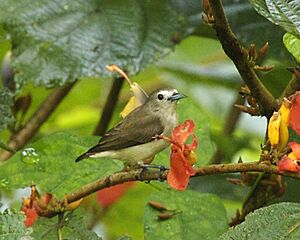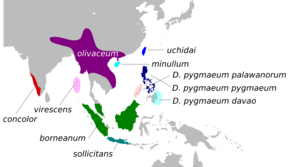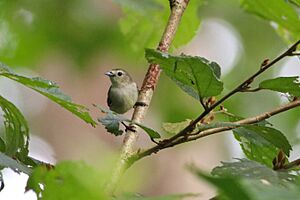Nilgiri flowerpecker facts for kids
Quick facts for kids Nilgiri flowerpecker |
|
|---|---|
 |
|
| feeding on Helicteres isora nectar | |
| Conservation status | |
| Scientific classification | |
| Genus: |
Dicaeum
|
| Species: |
concolor
|
 |
|
| Distribution of members in the species complex | |
The Nilgiri flowerpecker (Dicaeum concolor) is a very small bird that belongs to the flowerpecker family. It was once thought to be a type of plain flowerpecker. However, scientists now consider it a unique species.
Like other flowerpeckers, this bird mainly eats nectar and fruits. They search for food high up in the trees of forests. You can find them in India, especially in the southern parts. These birds do not migrate, meaning they stay in the same area all year. They are very important for spreading seeds and helping plants grow, especially mistletoes.
Contents
What Does It Look Like?
These birds are tiny, only about 9 cm (about 3.5 inches) long. It's hard to tell the difference between males and females because they look very similar.
The Nilgiri flowerpecker has pale brown feathers on its back and white feathers on its belly. It also has a whitish stripe above its eye. You can find these birds in the hill forests of the Western Ghats and Nilgiri hills in southern India.
Scientists like Pamela Rasmussen have studied these birds closely. They decided that the Nilgiri flowerpecker is its own species. This means it's different from other similar flowerpeckers found in places like northeastern India or the Andaman Islands.
Life and Habits
The Nilgiri flowerpecker is a common bird that lives in certain areas all the time. You can often spot it at the edges of woodlands, in farm areas, or near groups of trees, especially in hilly regions.
Sounds and Calls
The Nilgiri flowerpecker makes a sharp check sound. It can also make a quick series of ticking noises. Its song is a high-pitched, fast trill.
Reproduction and Nesting
The breeding season for the Nilgiri flowerpecker in the Nilgiris usually runs from January to April. They might even have a second group of chicks in May and June.
They build a special nest that looks like a small purse. This nest hangs from a tree or bush. Inside, the female bird lays two or three eggs.
What Do They Eat?
Like other flowerpeckers, the Nilgiri flowerpecker has a special feathery tongue. This tongue helps them sip nectar from flowers. But they don't just eat nectar! They also enjoy soft berries and small insects.
Role in Nature
These tiny birds play a big role in tropical forests. They are important pollinators, helping plants make seeds. They also help spread the seeds of mistletoes, which are plants that grow on other trees.



